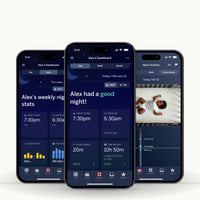Daniela Macia, Shambhavi Thakur, Mirella Dapretto, Monica Ordway, Maristella Lucchini, Natalie Barnett
Presented at the International Pediatric Sleep Association Conference, Glasgow, 2024
Introduction
Consistent bedtime routines have long been shown to help improve infant sleep and be beneficial in developing healthy sleep habits1,2. Over the past few years, the use of electronics by infants and toddlers has become ubiquitous with evidence that these devices are also used at bedtime, not just during the day3,4,5. Data on associations between infant sleep duration and electronics usage at bedtime are limited, although there is data to support the negative association between electronics usage at bedtime and sleep duration in older children and adolescents,6. The Brief Infant Sleep Questionnaire (BISQ) was fairly recently revised (Brief Infant Sleep Questionnaire -Revised [BISQ-R]) to include a question on electronic usage (‘e.g., television, smartphone, or tablet’) at bedtime. In this study we leveraged information from the BISQ-R together with objective sleep metrics from Nanit autovideosomonography to investigate the association between bedtime routines, electronics usage at bedtime and sleep duration in infants.
Methods
This study was approved by the Institutional Review Board of the University of California, Los Angeles. Caregivers of 598 infants ages 4-22 months (10.74 ± 3.7) were recruited for this study. Caregivers completed items on the BISQ-R and objective Total Sleep Time at night (TST) was collected using Nanit autovideosomnography for a period of 14 nights. Multiple linear regression analyses modeled the relationship between average TST and consistency of bedtime routines, and presence of electronics during bedtime as predictors, while controlling for infant age and gender..
Results
Caregivers reporting a consistent bedtime routine with their infants 6-7 nights per week had infants who slept 22±9.78 minutes more on average than those with only 0-3 nights of bedtime routine consistency (ϐ = -0.364, p<0.001). Infants whose caregivers reported that they did not use electronic devices at bedtime slept approximately 25±8.22 minutes longer compared to those infants with electronics present at bedtime (ϐ = -0.414, p=0.003). We found no significant relationship between bedtime routine consistency and electronic usage at bedtime (ϐ = -0.224, p=0.231).


Conclusion
Our findings indicate a positive relationship between bedtime routine consistency and infant sleep duration. These findings also suggest a negative relationship between incorporating electronic device usage into bedtime routines and infant sleep duration. However, electronics use at bedtime was not associated with a lack of consistent bedtime routine, which provides evidence of the increasing ubiquity of electronics use by infants at bedtime. More research is warranted to understand the underlying pathways of these associations and relationships between electronic use at bedtime and bedtime routine consistency. These preliminary findings, however, emphasize the importance of establishing stable bedtime patterns devoid of electronic distractions for promoting optimal sleep outcomes in infants.
References
- Fiese BH, Cai T, Sutter C, Bost KK. Bedtimes, bedtime routines, and children’s sleep across the first 2 years of life. Sleep. 2021;44(8):zsab045. doi:10.1093/sleep/zsab045
- Mindell JA, Leichman ES, Lee C, Williamson AA, Walters RM. Implementation of a nightly bedtime routine: How quickly do things improve? Infant Behav Dev. 2017;49:220–227. doi:10.1016/j.infbeh.2017.09.013
- Ribner AD, McHarg GG. Why won’t she sleep? Screen exposure and sleep patterns in young infants. Infant Behav Dev. 2019;57:101334. doi:10.1016/j.infbeh.2019.101334 4. Przybylski AK. Digital Screen Time and Pediatric Sleep: Evidence from a Preregistered Cohort Study. J Pediatr. 2019;205:218–223. doi:10.1016/j.jpeds.2018.09.054
- Neelon B, Østbye T, Benjamin-Neelon SE, Emond JA, O’Malley AJ, Kravitz RM. Associations between daily screen time and sleep in a racially and socioeconomically diverse sample of US infants: a prospective cohort study. BMJ Open. 2021;11(6):e044525. doi:10.1136/bmjopen-2020-044525
- Diler F, Başkale H. The influence of sleep patterns and screen time on the sleep needs of infants and toddlers: A cross-sectional study. J Pediatr Nurs. 2022;67:e201–e207. doi:10.1016/j.pedn.2022.07.014
About the researchers
The authors include Daniela Macia, Shambhavi Thakur, Mirella Dapretto, Monica Ordway, Maristella Lucchini, and Natalie Barnett.
- Shambhavi Thakur serves as Clinical Research Data Analyst at Nanit. She holds a Masters degree in Health Informatics and Life Sciences. She oversees the research collaborations with various universities and analyzes sleep data for internal as well as external studies.
- Dr. Monica Ordway’s NIH-funded program of research is focused on the understanding of the biosocial relationships that determine health and development in early childhood. Her expertise in community-based participatory research, innovative and non-invasive biomarkers of stress, and objective sleep measurement has helped to generate new knowledge about the role of the multidimensional constructs of sleep health in mitigating the risk of toxic stress among infants and toddlers who experience adversity. Prior to completing her PhD and a postdoctoral fellowship at Yale University, she worked as a primary care pediatric nurse practitioner for 10 years in a large urban practice. She continues to work as a nurse practitioner at the Yale Pediatric Sleep Clinic.
- Dr. Maristella Lucchini serves as Senior Clinical Researcher at Nanit. In her role, Maristella works to secure grant funding in collaboration with Nanit’s university research partners and supports the development of the company’s research collaborations around the world. Previously, Maristella served as an Assistant Research Scientist in the Division of Developmental Neuroscience, Department of Psychiatry at Columbia University Irving Medical Center where she led projects across several cohorts focusing on sleep health for pregnant and postpartum women and their children. Maristella’s research focused on underserved communities and sleep health disparities in the perinatal period. During her years as a postdoctoral researcher at Columbia University Irving Medical Center in the Department of Psychiatry, Maristella was selected to participate in the American Academy of Sleep Medicine Young Investigator Research Forum. She holds a Ph.D. in Biomedical Engineering from Politecnico di Milano.
- Dr. Natalie Barnett serves as VP of Clinical Research at Nanit. Natalie initiated sleep research collaborations at Nanit and in her current role, Natalie oversees collaborations with researchers at hospitals and universities around the world who use the Nanit camera to better understand pediatric sleep and leads the internal sleep and development research programs at Nanit. Natalie holds a Ph.D. in Genetics from the University of New England in Australia and a Postgraduate Certificate in Pediatric Sleep Science from the University of Western Australia. Natalie was an Assistant Professor in the Neurogenetics Unit at NYU School of Medicine prior to joining Nanit. Natalie is also the voice of Nanit's science-backed, personalized sleep tips delivered to users throughout their baby's first few years.


























